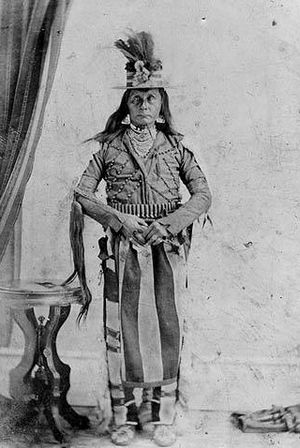Cutmouth John facts for kids
Quick facts for kids
Cutmouth John
|
|
|---|---|

Studio portrait of Cutmouth John, circa 1865.
|
|
| Allegiance | |
| Service/ |
|
| Unit | United States Army Indian Scouts |
| Battles/wars | Yakima War |
Cutmouth John was a Native American leader known by several names, including Poor Crane and Ya-Tin-Ee-Ah-Witz. He was a chief of the Cayuse tribe and served as a scout for the U.S. Army. It's not fully clear which tribe he originally came from, but some believed he was part of the Umatilla or Wasco tribes.
Early Life and Guiding
As Poor Crane, he was a guide and friend to a traveler named Thomas J. Farnham. In 1839, he led Farnham to the Whitman Mission, which had been built three years earlier. People described Poor Crane as a kind, middle-aged man and a caring father. He even lent Farnham his best saddle. His two young sons joined them on the trip to the mission.
Role in Conflicts
According to the journal of Lawrence Kip, a U.S. Army lieutenant, Cutmouth John guided the 4th Infantry Regiment in 1855. They were escorting Isaac Stevens to the Walla Walla Council. Kip wrote that Cutmouth John had lived near the Whitman Mission before the massacre. He was injured in a fight with Snake warriors in 1850 while hunting those responsible for the attack on the mission.
During the Yakima War, Cutmouth John fought alongside American troops at the Battle of Union Gap. It is believed he was responsible for the only death among the Yakama forces during that battle. Although sometimes popular with the Americans, Philip Sheridan reported an unusual event after the battle. Cutmouth John paraded through the U.S. camp wearing the religious clothes of Father Pandoza. These clothes came from St. Joseph's Mission, which had been raided by local militia the day before. Sheridan noted that this strange display "turned opinion against him." Despite this, Cutmouth John later fought with U.S. troops at the Battle of Four Lakes.
Legacy and Recognition
In 1891, the sculptor Olin Levi Warner created an 11-inch bronze sculpture of Poor Crane. It was titled Ya-Tin-Ee-Ah-Witz, Chief of the Cayuses. This was one of six sculptures Warner made of important Native American leaders from the Northwest. Warner met Poor Crane in 1891 when he was the Chief of the Cayuses. At that time, Poor Crane lived in northeastern Oregon on the Umatilla Reservation. He was described as someone who truly represented the wild lands. He lived simply, accepting life's challenges with strength. He believed that a person only needed two important qualities: bravery and truth.

